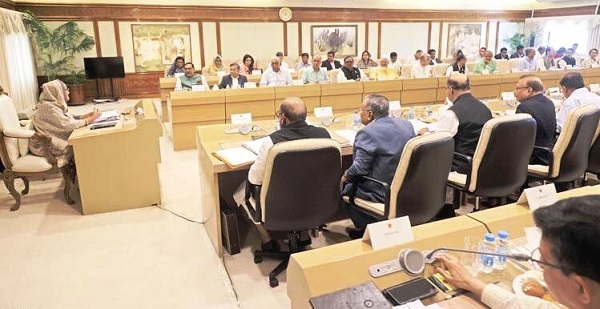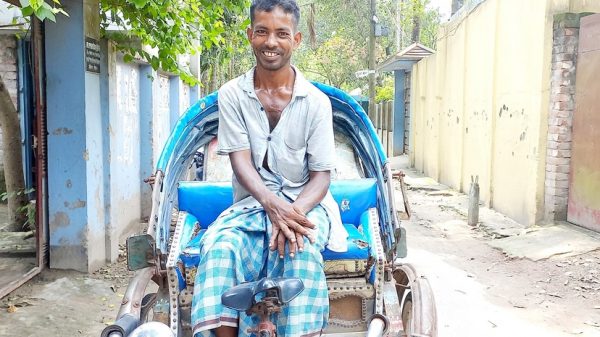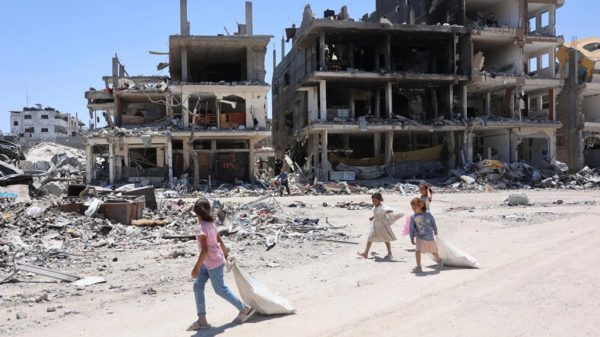Tagore’s Thoughts on Active Society and Today’s Bangladesh

Dr. Atiur Rahman:
Besides a poet and litterateur of global repute who won the first Nobel Prize from Asia, Rabindranath Tagore was an accomplished social reformer. His thoughts on society and economy remain unique even today. The way he defined development in terms of freedom from persistent ‘meagerness’ speaks volumes about his original thinking on sustainable development. The lines from the ‘Gitanjali’ saying ‘Whom you push down will pull you down’ aptly captures the tagline of the SDGs— ‘No one can be left behind’. In that sense, Tagore can be treated as one of the precursors of the SDGs.
Indeed, Tagore was a great believer in social activism. Humans always predominated his societal thinking. His ‘society’ wanted to thrive on living together. And his thoughts on ‘Nation’ originated from this all-embracing thinking as well. To him a nation could emerge only if there were a deeper relationship between humans in the past, present and, of course, future. According to Tagore, this relationship forms the bedrock of the eastern society. To him, a single man or woman was just a small piece. If five of them could sit together then they would have cultivated a relationship. And this relationship would be a capital for reforming a society to ease the creative path of humans. This thought process of Tagore clearly indicates that he was not merely a philosopher. He was also a doer. And he proved his worth when he was sent to East Bengal (today’s Bangladesh) to supervise family estates. He was just 22 when he stepped onto East Bengal. This was an eye-opening experience for Tagore. He could see both the positive and negative aspects of rural life from a very close quarter. He could thus comprehend the depth of the sorrows and happiness of the farmers, including women, who had to struggle hard just for survival. Besides obtaining sources of inspiration for writing creative poems, short stories, songs and other forms of literature from this direct contact with the rural people, he was also determined to find ways to ameliorate these difficulties. He felt deeply for these deprived people. He thought people were always trying to get help from outside, which he thought would not free them from deprivation. They needed to realize that they had the self-strength (‘atmashakti’) to overcome their predicament. Thus, he wrote in his ‘Bharatborshio Samaj’ (‘the Indian Society’): “… We must understand that the society is larger than anything else. In other countries the nation survived many revolutions, in our country the society survived even longer facing all the crises. That we have not been depleted to ashes despite revolution, exploitation, lack of freedom, and degradation for thousands of years is mainly due to the strength of our society. One must note the honesty and modesty of our people of all segments of the society leading to our sacrifices for others, sharing our wealth with our relatives as profound strengths of our society. For example, the security guard of a Sahib sends home Taka four out of his monthly salary of Taka seven; the deed writer who earns Taka fifteen a month does not fail in sharing his meagre income with his younger brother who is attending the college for higher education.” (‘Atmashakti’. Collective Works of Tagore, volume 2, p.623).
He did not, however, forget about the lack of progress in many parts of society. He was equally vocal about the undue pressure that the rich were putting on the poor in the name of maintaining so-called social norms. For example, a poor person was forced to sell all his properties or become badly indebted to perform shradhya (entertaining villagers to salvage the soul) of his dead father. To stop these social irregularities, he thought that people ought to have access to education to change their mindsets. To him education was the highway to civilization. We, therefore, have come to know that Tagore established hundreds of educational institutions including girls’ schools, technical schools and research institution for modernizing agriculture, import of high-yielding seeds and cows from other parts of the country, inviting experts to promote modern agriculture, developing the rural administration including the alternative dispute settlement institution called Salish and its appellate body called pargana to enlighten the rural people and avoid divisiveness in the society. He even got his son Rathindranath and son-in-law Nagen educated from Illinois University to help modernize agriculture in his estates. Some of the remnants of the power tillers and other equipment are still demonstrated in the museums in his estates. He established cooperatives including a formal agricultural bank to help his tenants get out of the clutches of the moneylenders who were exploiting them with usurious informal credit. His early investment in many areas of modernization of rural society including education, primary health, agriculture, livestock etc. has been paying us well in terms of stunning progress that we have been making in developing rural Bangladesh.
When Tagore first came to East Bengal, he was very curious about how his tenants were struggling for survival. He then started to approach them and learn more about their survival strategies. He was a keen observer. He planned sustainable development strategies for them only after collecting enough information. He believed in participatory planning and sharing of resources. When he started building local schools and dispensaries his estates shared a part of the expenditures and the beneficiaries were motivated to pay the other part. The idea was to show them that this was not charity. They all participated in building and running these social infrastructures. Tagore was aware of the inner strengths of a society reflected in terms of interpersonal relationships, family bonding, and all kinds of engagements in a rural society. Based on those strengths, he began developing rural organizations including cooperatives, educational and health institutions. As already indicated, the agricultural cooperative bank was another innovative move of Tagore to help his tenants. Besides economic institutions, he started building socio-cultural institutions like rural fair, folk music and drama, boat-riding competition etc. to alleviate the mental poverty of the tenants as well.
His village organizations were built on the assumption that the rural power structure was asymmetric and needed a higher level of participation from all segments of the population. He was always for many and against a few. He used to remind all who were managing rural institutions that there had to be a balance between power and restraint. Tagore was always in favour of creating an environment where the idea of sacrifice ought to be central to any rural institution. ‘Together we grow’ was the motto of his institution-building so that vices of communalism and casteism could be shunned. While in Shilaidaha, he invited both Muslim and Hindu tenants for celebrating ‘rakhi bondhan’ (a tradition of brotherly bonding). They were also required to sit together in the same indigenous carpets (‘sataranchi’) during the ‘punnah’ (Bengali New Year celebration along with collection of rent). He was also welcoming the rural folk bards (‘bauls’) for both encouraging rural cultural heritage and breaking the iron clad of casteism.
He replicated some of the creative initiatives that he took in East Bengal in Sriniketan at the outskirts of Shantiniketan, where he started his innovative school and later Vishwa Bharati, the multi-disciplinary university. He got the lavish support of agronomist and philanthropist Leonard Elmhirst in dismantling the vices of casteism and communalism while advancing his project in progressive education and rural reconstruction in Sriniketan. With his support Tagore established a youth organization called ‘broti balok shangathan’ to make the rural youths self-reliant, and also encouraged them to remain engaged in social reconstruction. They were trained to remain disciplined and contribute towards bringing peace in the community which used to be deeply divided. It was thought by many that Tagore must have been swayed by his creative thoughts as expressed in his literature. But surprisingly, he proved to be much more down to earth while implementing those creative ideas. In fact, he wanted to leave a replicable model of his rural reconstruction related activities for posterity. Not surprisingly, he was, therefore, able to write, “If I can light real fire among those who are around me, this fire will carry its own flame…This will then expand to its branches and sub-branches and provide shadow and fruits like a banyan tree.’’(‘Sriniketan’, The Collective Works of Tagore, volume fourteen, p.362). One cannot say that all hopes and aspirations of Tagore were fulfilled. He himself was not very happy with the implementation process of his ideas. Thus, he wrote, “When I realized that people were not interested in implementing these ideas which they thought were merely poetic creations of a poet then I pledged to put these ideas into practice myself.” (‘Asram and Rupayan’). Maybe he wrote the song ‘move alone if nobody responds to your call’ out of that anguish. Indeed, he was a committed performer. He not only wrote songs but also sang them. He not only wrote the drama but also acted on the stage. He not only wrote dance dramas but also danced himself before the audience. Similarly, he led the implementation of many of his ideas in rural reconstruction and modern education with a message to the younger generation to ‘walk the talk.’ Also, he emphasized on ethics and sacrifices to the volunteers who were aiding him in these activities. He was always keen on upholding these values even in chaotic conditions.
In other words, he used to see this world in multiple incarnations—sometimes as a sage, other times as a creative writer or poet and most of the time as a doer. He believed in learning by doing. He also believed in immersing his ideas in reality. That is why Tagore remains so relevant even today. During his last days, when the Second World War was raging on humanity, he was deeply distressed. Yet, he never lost hope. He always felt that good sense would prevail.
Today’s world is even worse than Tagore’s one. The invisible enemy called the Coronavirus has held the whole world at ransom. The world has been clearly divided between those countries who have sufficient vaccines and those who do not. Never ever has the world leadership appeared to be so uncompassionate. Self-interest and greed have overwhelmed the global community. Vaccines have been turned into a commercial good, defying the age-old dictum of many humanitarian leaders including our Premier. If things continue to persist like this the whole world will face a catastrophe that some of the better-off nations may not have anticipated. This is a globalized world. And this virus knows no boundaries. So even if the leaders of the developed world think that they can get away with their stock of vaccines, the pandemic may still hit back at its opportune moment. So, if we want to avoid a civilizational crisis as anticipated by Tagore, it is high time that the world came together to help humanity survive defying this disaster.
Beyond the global scenario, when we look at our own society we are equally pained by the overwhelming inequality and misplaced priorities even when we are fighting a disaster of global proportions. The dream of equity of our Father of the Nation is still far away from realization. The basic rights of all citizens, including health services for all, are constantly violated. The society at large has lost its touch of activism as dreamt by Tagore. Today’s society is for a few and not for many. However, some of his ideas have certainly been put in place. Look at our agriculture. This sector has been modernized and diversified as desired by Tagore and later Bangabandhu. Even though the quality of education is far from satisfactory, the access to it has significantly increased. The early emphasis on primary education by Bangabandhu and later support to girls’ education by the current Premier has been paying off in enhancing women empowerment and female employment.
Unfortunately, the ethics in our society, including that in the education system, have been contrary to the expectations of Tagore and Bangabandhu. Both these greatest Bengalis were in favour of autonomy of villages in running their economy and society, either with the help of village organization or cooperatives. This remains a daydream even today. The local governments have not been gaining ground either. The rural power structure has been badly polluted. The community spirit is now missing. The divisive politics and greed have overwhelmed the all-society approach of the community. Yet, the vibrant rural economy strengthened by thriving diversified agriculture, greater flow of remittances and hence increased non-farm income has been a source of solace for those who have lost income earning opportunities in the urban economy, both formal and informal. The digital payment system including mobile and agent banking has been a boon to rural society. We are happy to see some of Tagore’s aspirations being translated in rural Bangladesh. Despite many challenges, let the inclusive and humane thoughts of Tagore and Bangabandhu continue to enrich our developmental thinking in the days to come.
The author is Bangabandhu Chair Professor, Dhaka University and former Governor, Bangladesh Bank. He can be reached at: dratiur@gmail.com





























Leave a Reply